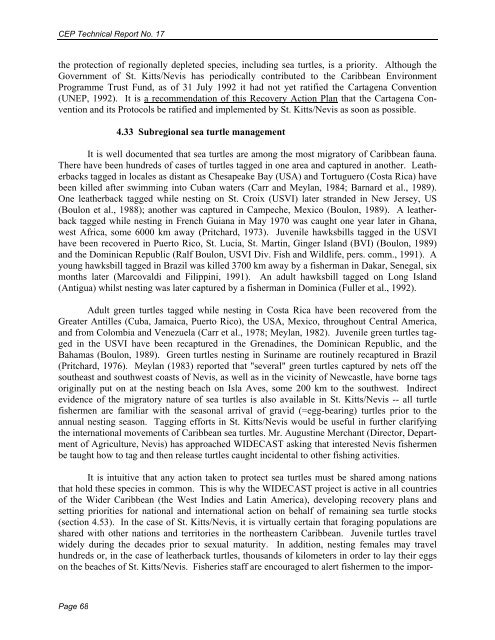Sea Turtle Recovery Action Plan for St. Kitts and Nevis - WIDECAST
Sea Turtle Recovery Action Plan for St. Kitts and Nevis - WIDECAST
Sea Turtle Recovery Action Plan for St. Kitts and Nevis - WIDECAST
You also want an ePaper? Increase the reach of your titles
YUMPU automatically turns print PDFs into web optimized ePapers that Google loves.
CEP Technical Report No. 17<br />
the protection of regionally depleted species, including sea turtles, is a priority. Although the<br />
Government of <strong>St</strong>. <strong>Kitts</strong>/<strong>Nevis</strong> has periodically contributed to the Caribbean Environment<br />
Programme Trust Fund, as of 31 July 1992 it had not yet ratified the Cartagena Convention<br />
(UNEP, 1992). It is a recommendation of this <strong>Recovery</strong> <strong>Action</strong> <strong>Plan</strong> that the Cartagena Convention<br />
<strong>and</strong> its Protocols be ratified <strong>and</strong> implemented by <strong>St</strong>. <strong>Kitts</strong>/<strong>Nevis</strong> as soon as possible.<br />
4.33 Subregional sea turtle management<br />
It is well documented that sea turtles are among the most migratory of Caribbean fauna.<br />
There have been hundreds of cases of turtles tagged in one area <strong>and</strong> captured in another. Leatherbacks<br />
tagged in locales as distant as Chesapeake Bay (USA) <strong>and</strong> Tortuguero (Costa Rica) have<br />
been killed after swimming into Cuban waters (Carr <strong>and</strong> Meylan, 1984; Barnard et al., 1989).<br />
One leatherback tagged while nesting on <strong>St</strong>. Croix (USVI) later str<strong>and</strong>ed in New Jersey, US<br />
(Boulon et al., 1988); another was captured in Campeche, Mexico (Boulon, 1989). A leatherback<br />
tagged while nesting in French Guiana in May 1970 was caught one year later in Ghana,<br />
west Africa, some 6000 km away (Pritchard, 1973). Juvenile hawksbills tagged in the USVI<br />
have been recovered in Puerto Rico, <strong>St</strong>. Lucia, <strong>St</strong>. Martin, Ginger Isl<strong>and</strong> (BVI) (Boulon, 1989)<br />
<strong>and</strong> the Dominican Republic (Ralf Boulon, USVI Div. Fish <strong>and</strong> Wildlife, pers. comm., 1991). A<br />
young hawksbill tagged in Brazil was killed 3700 km away by a fisherman in Dakar, Senegal, six<br />
months later (Marcovaldi <strong>and</strong> Filippini, 1991). An adult hawksbill tagged on Long Isl<strong>and</strong><br />
(Antigua) whilst nesting was later captured by a fisherman in Dominica (Fuller et al., 1992).<br />
Adult green turtles tagged while nesting in Costa Rica have been recovered from the<br />
Greater Antilles (Cuba, Jamaica, Puerto Rico), the USA, Mexico, throughout Central America,<br />
<strong>and</strong> from Colombia <strong>and</strong> Venezuela (Carr et al., 1978; Meylan, 1982). Juvenile green turtles tagged<br />
in the USVI have been recaptured in the Grenadines, the Dominican Republic, <strong>and</strong> the<br />
Bahamas (Boulon, 1989). Green turtles nesting in Suriname are routinely recaptured in Brazil<br />
(Pritchard, 1976). Meylan (1983) reported that "several" green turtles captured by nets off the<br />
southeast <strong>and</strong> southwest coasts of <strong>Nevis</strong>, as well as in the vicinity of Newcastle, have borne tags<br />
originally put on at the nesting beach on Isla Aves, some 200 km to the southwest. Indirect<br />
evidence of the migratory nature of sea turtles is also available in <strong>St</strong>. <strong>Kitts</strong>/<strong>Nevis</strong> -- all turtle<br />
fishermen are familiar with the seasonal arrival of gravid (=egg-bearing) turtles prior to the<br />
annual nesting season. Tagging ef<strong>for</strong>ts in <strong>St</strong>. <strong>Kitts</strong>/<strong>Nevis</strong> would be useful in further clarifying<br />
the international movements of Caribbean sea turtles. Mr. Augustine Merchant (Director, Department<br />
of Agriculture, <strong>Nevis</strong>) has approached <strong>WIDECAST</strong> asking that interested <strong>Nevis</strong> fishermen<br />
be taught how to tag <strong>and</strong> then release turtles caught incidental to other fishing activities.<br />
It is intuitive that any action taken to protect sea turtles must be shared among nations<br />
that hold these species in common. This is why the <strong>WIDECAST</strong> project is active in all countries<br />
of the Wider Caribbean (the West Indies <strong>and</strong> Latin America), developing recovery plans <strong>and</strong><br />
setting priorities <strong>for</strong> national <strong>and</strong> international action on behalf of remaining sea turtle stocks<br />
(section 4.53). In the case of <strong>St</strong>. <strong>Kitts</strong>/<strong>Nevis</strong>, it is virtually certain that <strong>for</strong>aging populations are<br />
shared with other nations <strong>and</strong> territories in the northeastern Caribbean. Juvenile turtles travel<br />
widely during the decades prior to sexual maturity. In addition, nesting females may travel<br />
hundreds or, in the case of leatherback turtles, thous<strong>and</strong>s of kilometers in order to lay their eggs<br />
on the beaches of <strong>St</strong>. <strong>Kitts</strong>/<strong>Nevis</strong>. Fisheries staff are encouraged to alert fishermen to the impor-<br />
Page 68
















